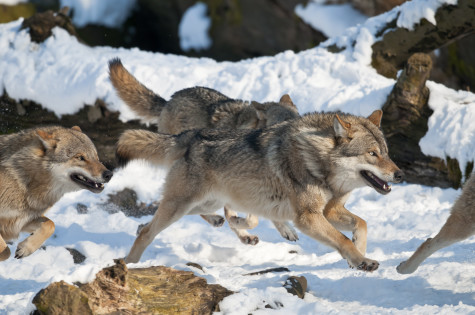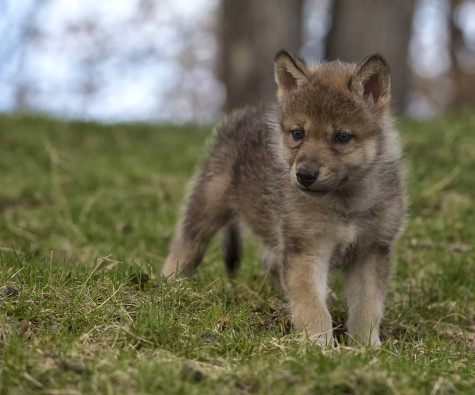 Four years ago when I had a powerful encounter with a healthy wolf pack just meters from my home, I knew it was a quintessentially Northern experience. The million-odd square kilometers of the Northwest Territories are so sparsely populated by humans and so well-stocked with wolf prey that wild canids have fewer problems than their brethren to the south in Alberta. There, habitat loss is part of the issue, as with any threatened species, but the main determinant of wolf survival is whether or not we want them dead.
Four years ago when I had a powerful encounter with a healthy wolf pack just meters from my home, I knew it was a quintessentially Northern experience. The million-odd square kilometers of the Northwest Territories are so sparsely populated by humans and so well-stocked with wolf prey that wild canids have fewer problems than their brethren to the south in Alberta. There, habitat loss is part of the issue, as with any threatened species, but the main determinant of wolf survival is whether or not we want them dead.
It’s a question we still can’t seem to decide on. Ranchers around the Rockies successfully wiped out wolves near Banff at the turn of the century and to this day, anyone can shoot a wolf in Alberta if it’s within 8km of their property. At one point, 80% of the province’s wolves were exterminated by a strychnine campaign aimed at rabid skunks and foxes. In Yellowstone, the birthplace of the national park idea, conventional wisdom included regular predator culls under the bottom-up theory of ecosystem regulation.
The result has been a bloated and sedentary elk population that doesn’t even have the skittish instincts to keep it moving before it overgrazes an area. When I did a writing residency in Banff, the elk near my little writing studio were so blasé about approaching predators that they had to be scared off with an air horn when I wanted to return to the main lodge. At the sound of the raucous blast, they sauntered off a few meters away and kept grazing.
Ground nesting birds in regions overrun by elk can’t find the cover to protect their young. Beavers starve, and aspen are stripped past recovery.
Chronic Wasting Disease in deer arose in the game farms and spread to wild populations through nose-to-nose contact through single-layer fences. Now it’s here to stay because it arrived in a wolf-free environment. In wolf country, the first sign of weakness in an ungulate – mental or physical –will mark it for swift predation, before it has a chance to drip prions all over the ground and spread its misery through the herd.
 Wolf biologist Kevin Van Tighem has worked with Alberta ranchers and environmentalists to promote reason on both sides of the debate. He argues in The Homeward Wolf (Rocky Mountain Books) that we can’t treat every wolf shooting as an outrage, because the truth is that wolves sometimes get a taste for cattle and become costly nuisances.
Wolf biologist Kevin Van Tighem has worked with Alberta ranchers and environmentalists to promote reason on both sides of the debate. He argues in The Homeward Wolf (Rocky Mountain Books) that we can’t treat every wolf shooting as an outrage, because the truth is that wolves sometimes get a taste for cattle and become costly nuisances.
On the other hand, indiscriminate killing of wolves near farmland “just in case” is a rookie mistake – a wolf pack that has learned to specialize in wild prey is your best defense against cow-hungry wolves moving in. Once a pack has experience hunting a certain kind of animal, it will stick with what it knows. One rancher Van Tighem talked to was initially quite hostile to wolves, but realized his neighbourhood pack had so little interest in his livestock that they would actually chase deer through his herds with a single-minded focus.
Now, with the help of the Endangered Species Act, a stronger piece of legislation than the toothless Canadian equivalent, the wolves are returning. A couple of dozen wolves were airlifted into Yellowstone from Alberta and they landed in wolf heaven, with so many elk to eat that they started birthing two and three litters per year. They are closely monitored and their vast journeys better understood. When we fix radio collars to wolves, as unpleasant as the capture may be for the animal, it actually seems to raise the collared wolf’s social status within the pack.
Among pro-active conservationists, the name of the game is no longer to clutch at the remaining protected areas with increasing jealousy, kicking and screaming at any hint of development. Instead, there is an ambitious plan called Yellowstone to Yukon that would connect protected habitats to form a single system of land and waterways along a mighty North-South corridor. Privileged wildlife areas of the North could be harnessed for the benefit of beleaguered species in Southern Canada and the Northern United States.
Protected areas, if isolated, take on the biological properties of islands and lose their biodiversity, but if one connects them – sometimes just by lining highways with high fences punctuated by wildlife crossings – their value compounds and allows widely dispersing species like wolves to occupy a reasonable range, safe from hostility.
Van Tighem believes the resulting life among healthy predator populations would enrich humans too. “Humility tastes bitter only at first; then it starts to taste a lot like belonging,” he says.
Images: c/o Shutterstock
Radio-collared wolves have higher status? Wolves do bling!
I was surprised by that too, Steve. I wondered whether it makes their ruffs look fuller or something. The collars are quite heavy. I once held one that had ejected itself after its battery ran low. Also, as an aside, wolves reek, apparently.